Worlding Public Cultures
𝘳𝘦* : 𝘪𝘮𝘢𝘨𝘪𝘯𝘪𝘯𝘨 / 𝘤𝘳é𝘦𝘳 / 𝘣𝘶𝘪𝘭𝘥𝘪𝘯𝘨 / 𝘧𝘢𝘪𝘳𝘦 / 𝘮𝘢𝘱𝘱𝘪𝘯𝘨 / 𝘤𝘰𝘯𝘯𝘢𝘪𝘴𝘴𝘢𝘯𝘤𝘦 /…
Curators: Manar Abo Touk, Lorraine Doucet Sisto et Varda Nisar
March 9 - April 6, 2023
Vernissage: March 9th 2023, 5 pm to 7 pm
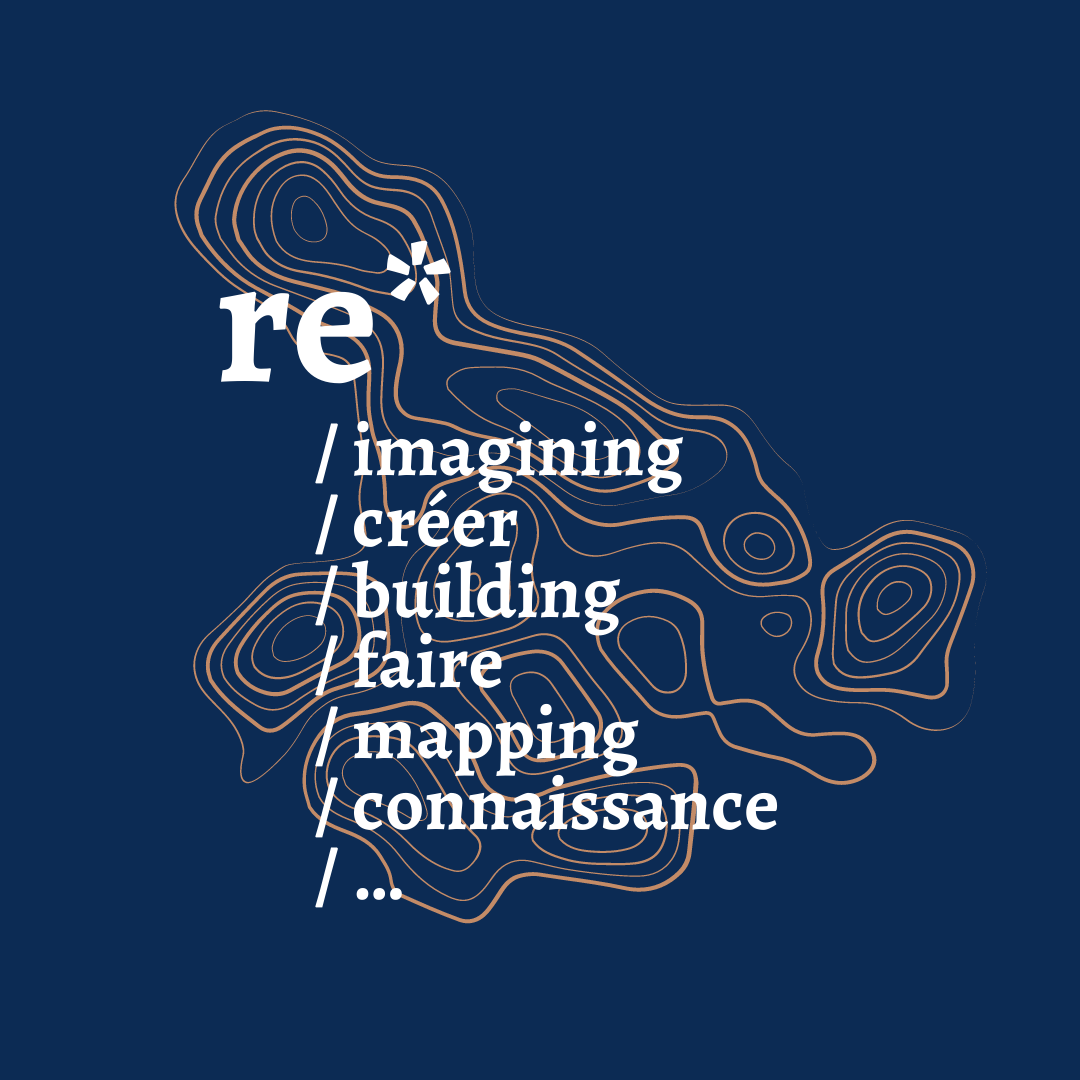
Visual branding by Lorraine Doucet-Sisto, 2022.
Exhibition description
re* allows for the possibilities to unlearn and relearn the diverse world-making practices that continue to exist and thrive, despite colonial attempts to eradicate them under the guise of progress.
The exhibition is conceived as a critical and collective reflection on the themes of worlding and world-making. We understand world-making as an endeavor that creates life, cosmos, heaven and earth; a sacred act contributing to the pluriversality of modes of being; a practice that has always guarded itself against the worlding desires of colonial, heteronormative and patriarchal modes of being.
re* offers a counterpoint to colonial histories and archival practices. The artworks included in the exhibition reimagine and redefine ideas around time, space, land and languages. The works of artists rudi aker, Pansee Atta, Amin Rehman, and Swapnaa Tamhane foreground different possibilities for reclaiming languages and histories, resisting and refuting imposed geographies, and reframing pasts and futures.
Taking place at the Concordia University Webster Library and FOFA Art Gallery on unceded Kanien'kehá:ka traditional territory, re* is part of the Worlding Public Cultures 2023 Tiohtià:ke/Montreal colloquium.
About the Works
rudi aker
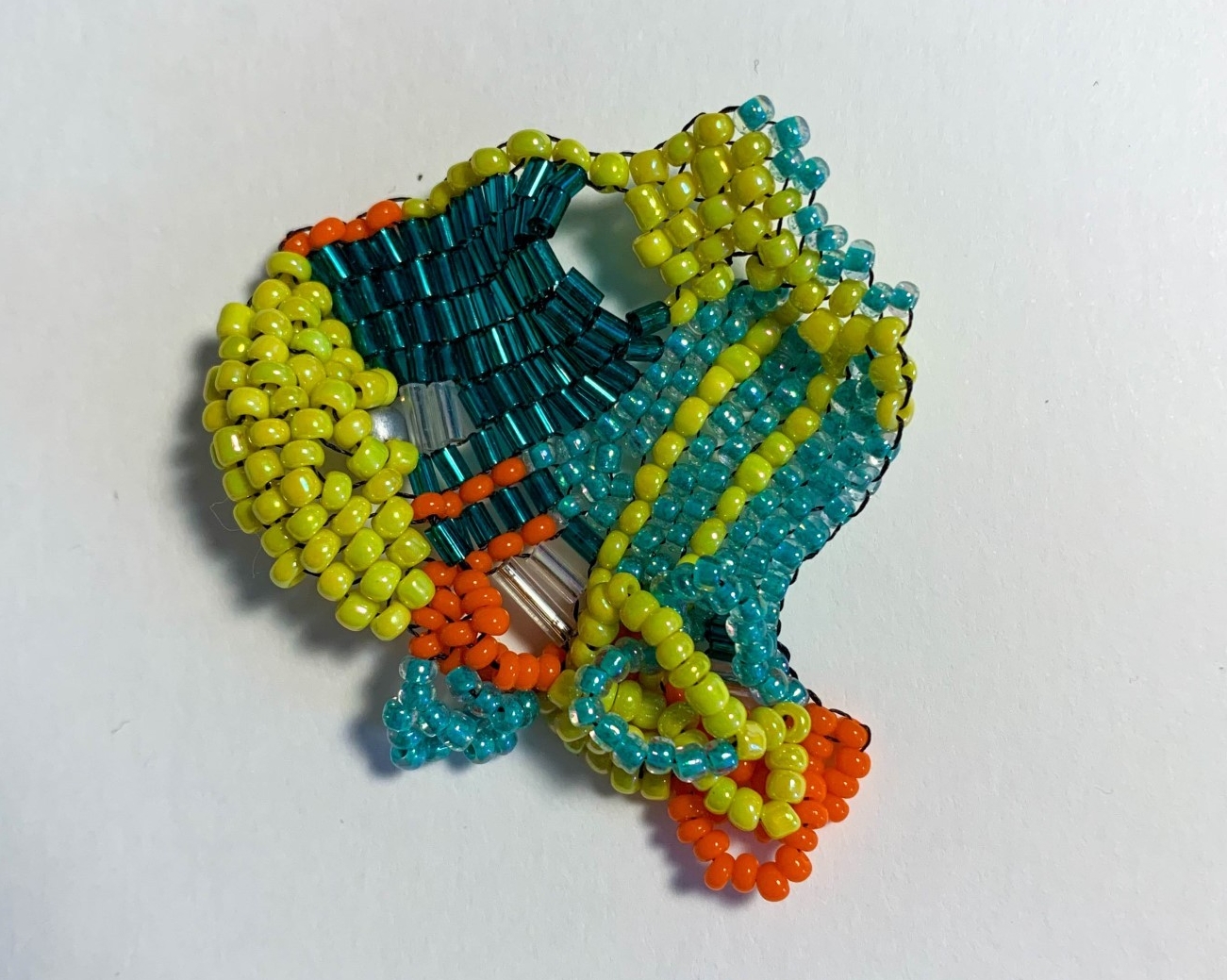 rudi aker, eqpahak map, 2019, glass beads, nylon thread, crochet cotton, 13 x2.5 x 13 cm. Photo credit: Courtesy of the artists
rudi aker, eqpahak map, 2019, glass beads, nylon thread, crochet cotton, 13 x2.5 x 13 cm. Photo credit: Courtesy of the artists
topographies of a homeplace: wolastokuk
topographies of a homeplace is multimedia work engaging with topographical beadwork to explore counter-cartographic mnemonic narratives. this project began in the form of a book, images of the beaded topographies accompanied by automatic prose divulging into the memories of spaces near and defined by water. since its conception, it has also evolved into a mobile practice of community-building and communal memory-making and sharing.
Pansee Atta
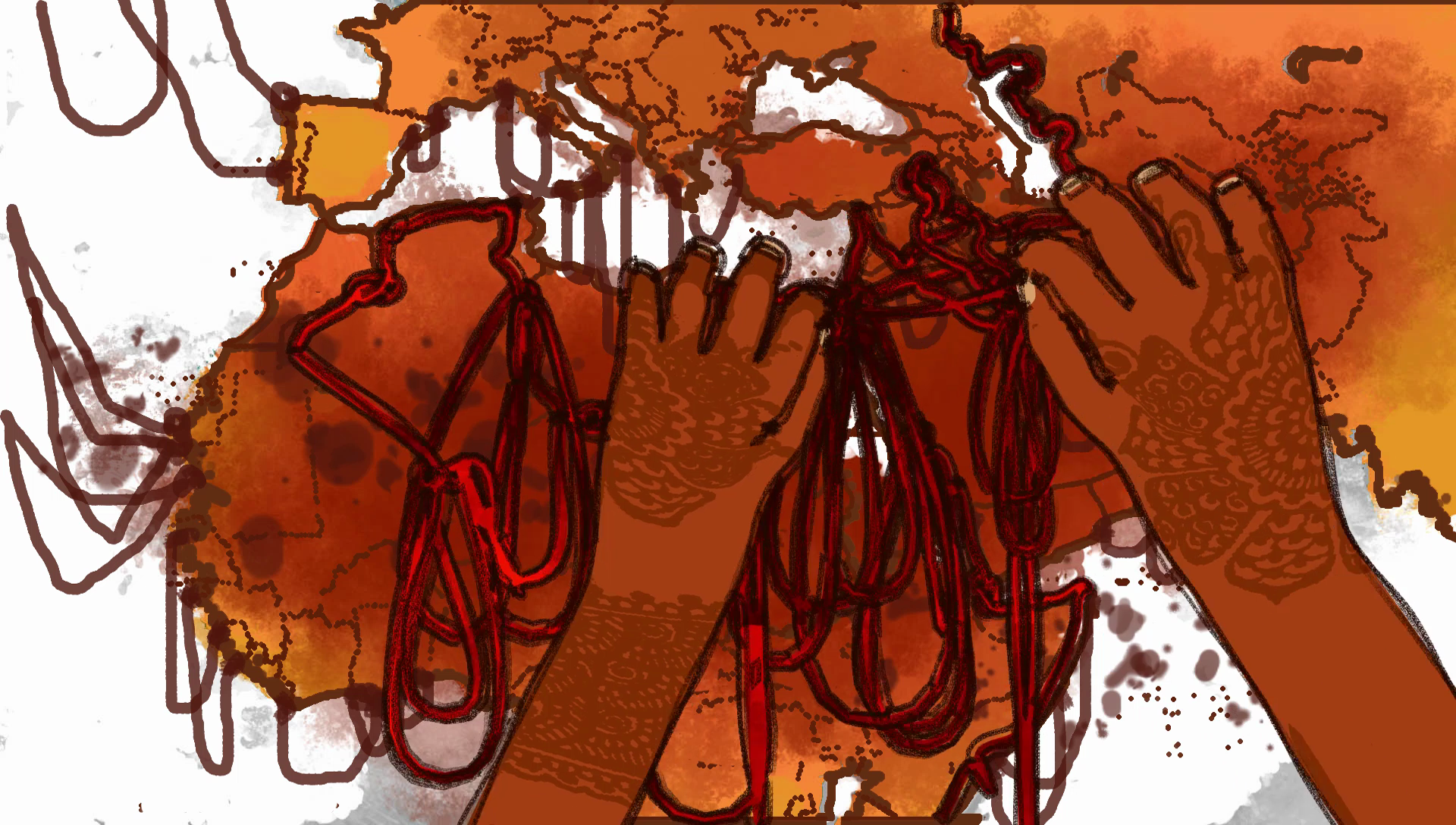 Pansee Atta, Projections, 2016, animation still, 5 min. Photo credit: Courtesy of the artists
Pansee Atta, Projections, 2016, animation still, 5 min. Photo credit: Courtesy of the artists
PROJECTIONS
In cartography, a projection is a transformation of the three-dimensional shape of the planet onto a two-dimensional surface. Mapped projections, by definition, distort the surface to some extent: some of the most accurate projections are less legible due to the lines of division and intersection, whereas some of the most recognizable projections (such as the Mercator projection) distort large portions of the globe by shrinking equatorial regions in comparison to northern landmasses. In psychological terms, projection refers to the impulse to see aspects of oneself — accurately or inaccurately — in others. Between these two definitions of projection lay fertile grounds for considering the land through the lens of both the affective and the political. It underscores the impact of the epistemic violence of misrepresentation: the map becomes a way of understanding the non-Western world and racialized bodies, so that the ‘distorted’ map imposes just as real a set of political restrictions as the ‘accurate’ one. As a point of departure, this project seeks to ask: How do racialized bodies navigate both geographic and social space? How are bodies codified as ‘excessive’ through normative conceptualizations of space and geography? And how is belonging asserted and denied through interactions with the land and its signifiers? By intervening upon images of the map, the border, and the earth, this project seeks to visualize the tension between belonging and rejection, expressing the effects of that tension through the use of animated images that cycle indefinitely and interact variously with the surfaces upon which they are projected. Dislocation — physical, social, and psychic — is made manifest in its different forms through animated work that is tactile and visceral despite its intangibility.
The artist gratefully acknowledges the financial support of the City of Ottawa, without which this project would not have been possible.
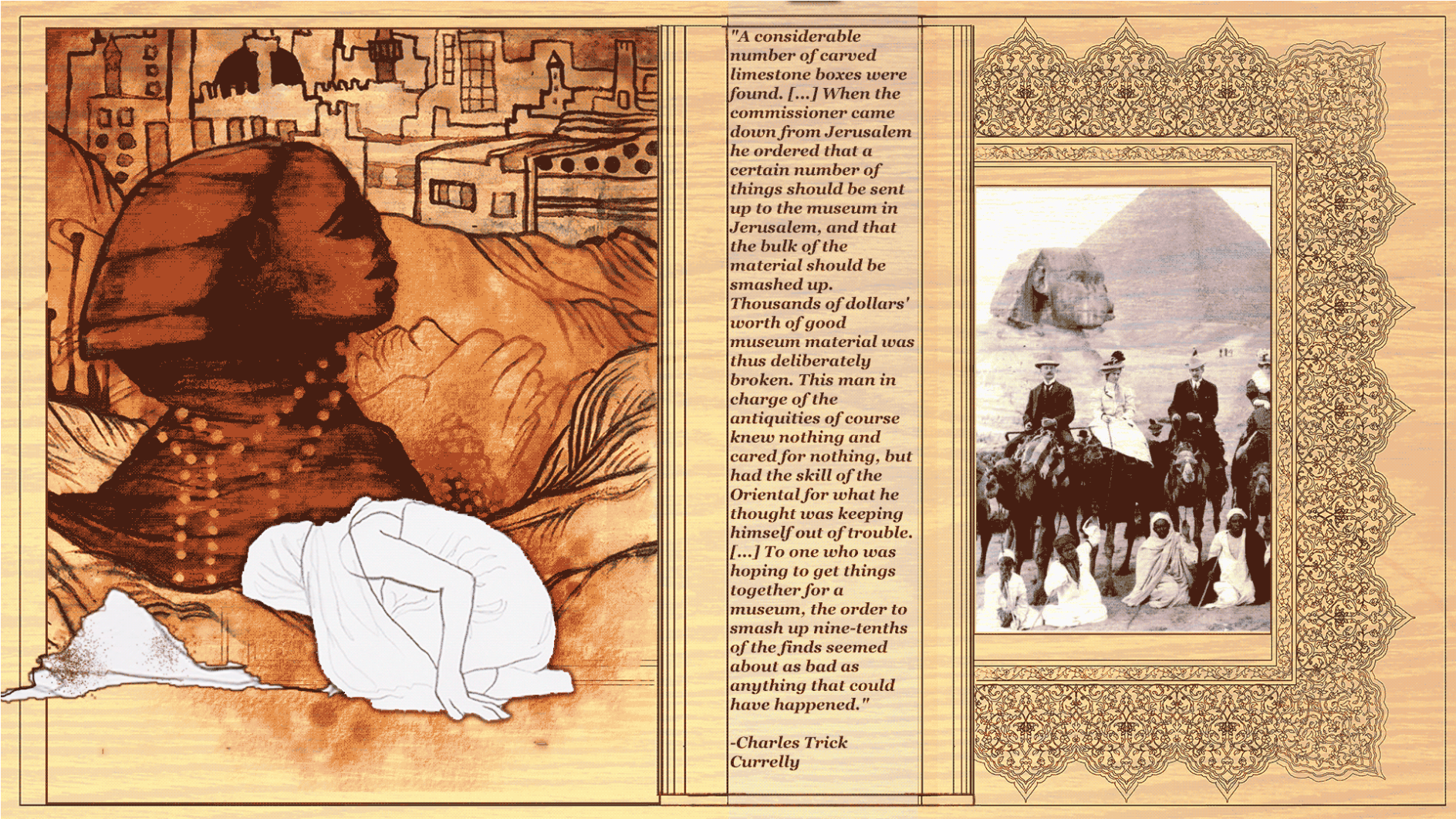 Pansee Atta, 2015, Burial/Excavation, image still, animation. Photo credit: Courtesy of the artists
Pansee Atta, 2015, Burial/Excavation, image still, animation. Photo credit: Courtesy of the artists
Myth Marks
Myth Marks is a series of six animations that comprise a portion of my graduating MA project in Cultural Studies at Queen’s University. In this project, I undertook a research/creation methodology to think through the decolonization of the Canadian cultural institution. Myth Marks critically examines the ways that the ethnographic display of ‘Islamic Art’ (and art that works in didactic relation to Muslim bodies) is used as part of ongoing projects of colonization. These animations consider these questions from an experiential starting point, meditating on my own affective reactions to racializing discourses in the Canadian cultural sphere. I did this as a way of prioritizing the racialized, gendered body as a legitimate starting point for critical discourse, which works alongside the politics and policies that govern institutions and circumscribe the limitations of representation in such a framework. Myth Marks seeks to question the apparently clear-cut dividing lines that demark high art from craft, institutions from communities, professionals from amateurs, ‘legitimate’ voices from illegible ones. By doing so, it works as part of an intersectional approach to decolonization, one that considers the multiplicity of erasures experienced by Queer women of colour from essentializing narratives of Islam and immigration.
Amin Rehman
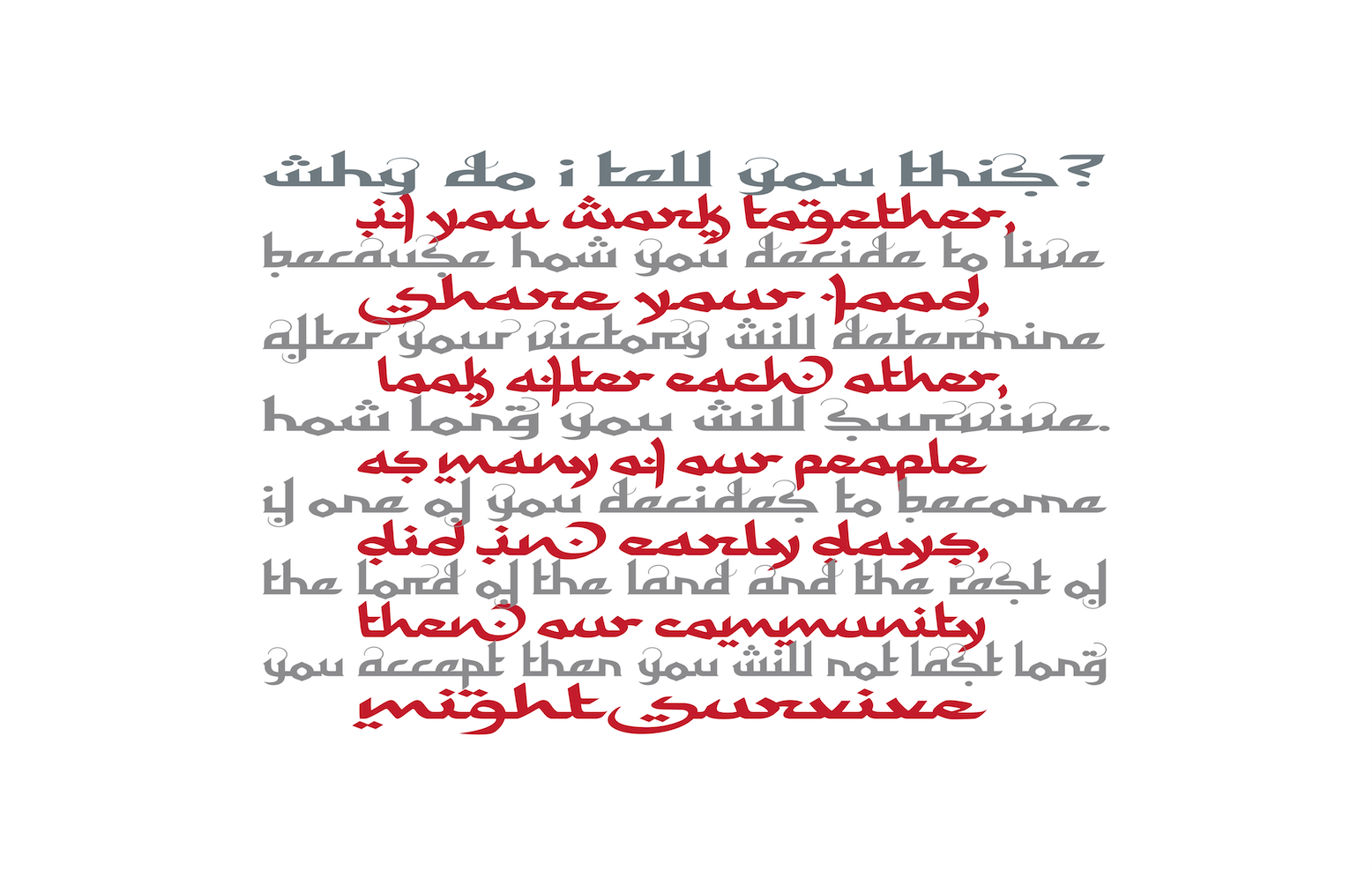 Amin Rehman, Why do I tell you this?, 2013, vinyl Print, 194" x 125"
Photo credit: Courtesy of the artists
Amin Rehman, Why do I tell you this?, 2013, vinyl Print, 194" x 125"
Photo credit: Courtesy of the artists
Why do I tell you this?
This artwork is part of a series featured in the exhibition Other Histories. Installed in FOFA's Courtyard, this work is a collaborative project by London-based activist, novelist and writer Tariq Ali and the artist Amin Rehman. The project investigates and questions themes such as violence, conflict and war to highlight the complexities of a global ideology in the context of neo-colonialism and aggressive world capitalization.
Text in red
if you work together
share your food
look after each other,
as many of our people
did in the early days
then our community
might survive
Text in grey
why do i tell you this ?
because how you decide to live
after your victory will determine
how long you will survive.
if one of you decides to become
the lord of the land and the rest of
you accept then you will not last long
-Tariq Ali, A sultan in Palermo, 2005.
The artist gratefully acknowledges the support of the Canada Council for the Arts through the Explore and Create Visual Arts Grant; Ontario Arts Council through the Visual Arts Grant; and, Toronto Arts Council through the Visual Arts Grant.
Swapnaa Tamhane
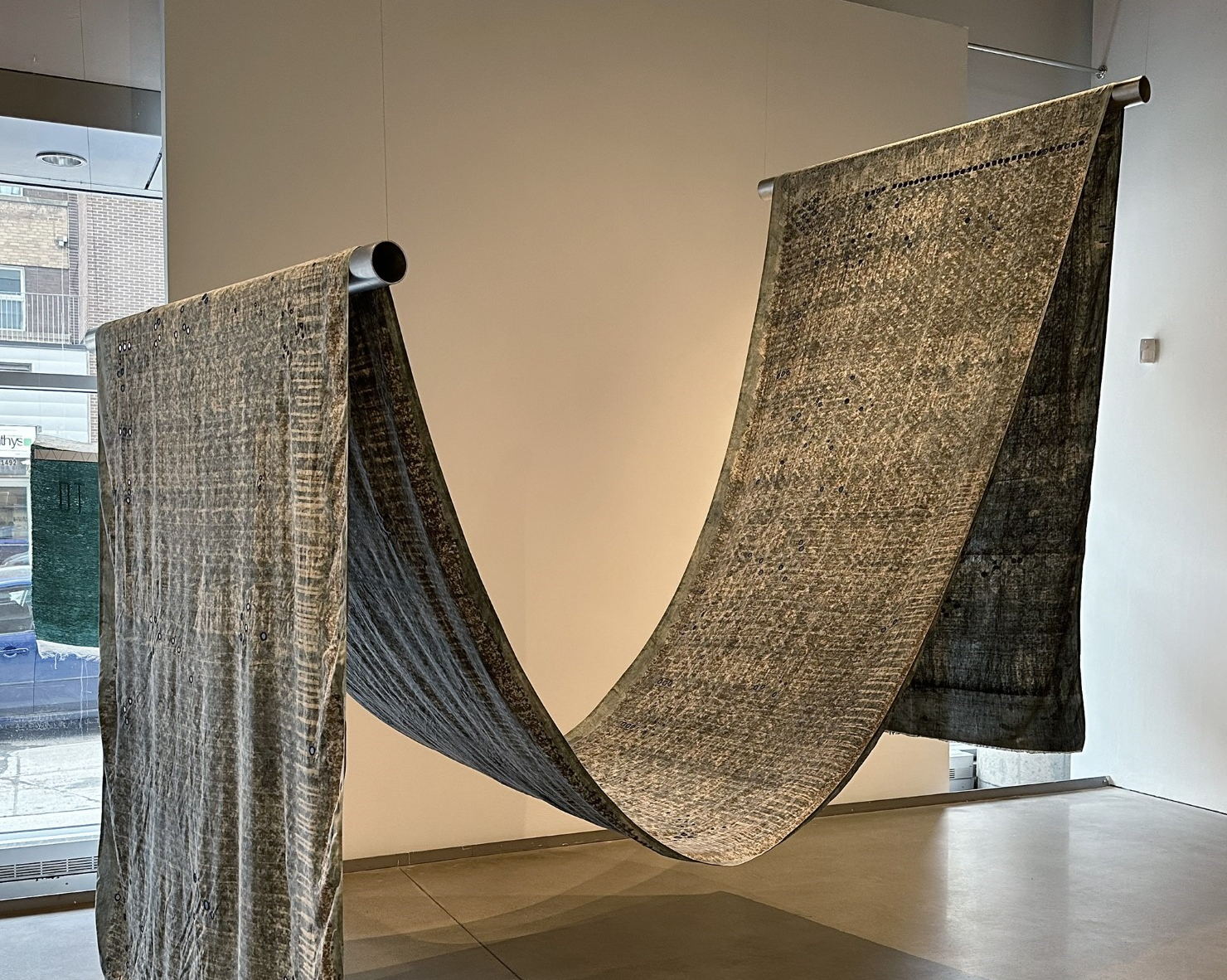 Swapnaa Tamhane, Achadiya 1,2020-2021, cotton, mirroirs, 26’ x 40”
Photo credit: Laurence Poirier
Swapnaa Tamhane, Achadiya 1,2020-2021, cotton, mirroirs, 26’ x 40”
Photo credit: Laurence Poirier
Achadiya
The “achadiya” is the dropcloth that blocks printers lay over their long tables, prior to starting the printing process. The achadiya is usually a heavier cloth that may have imperfections or is recycled and absorbs the excess resist during the printing process. While the artisan-designer, Salemamad Khatri based in Kutch, Gujarat, was printing the panels for my artwork Mobile Palace, I asked him to keep the “achadiya”, which he also uses for printing Ajrakh motifs on dupattas and saris for his ongoing commercial work. These dropcloths have been mordanted and dyed in indigo, revealing an incredible imprinting and layering of my motifs that quote Corbusier’s Mill Owners’ Association Building, and the Ajrakh motifs, which are believed to be from Islamic architecture. With some of the achadiya, I have responded to the imprints with the addition of mirrors, inspired by the use of mirrors in Kutch which appears in their architecture and embroidery on textiles. Simultaneously, master craftswomen in Kutch are doing skillful shiska-kam or mirror-work embroidery, also responding to the imprints. I have treated the process of placing the mirrors similar to how I work with drawing and mark-making. Although I have given the craftswomen this work with general instructions and examples of what I want to achieve, it is up to them to make the decisions about the placement of the mirrors. This series of achadiyas is about bringing to light the things that were never meant to be seen.
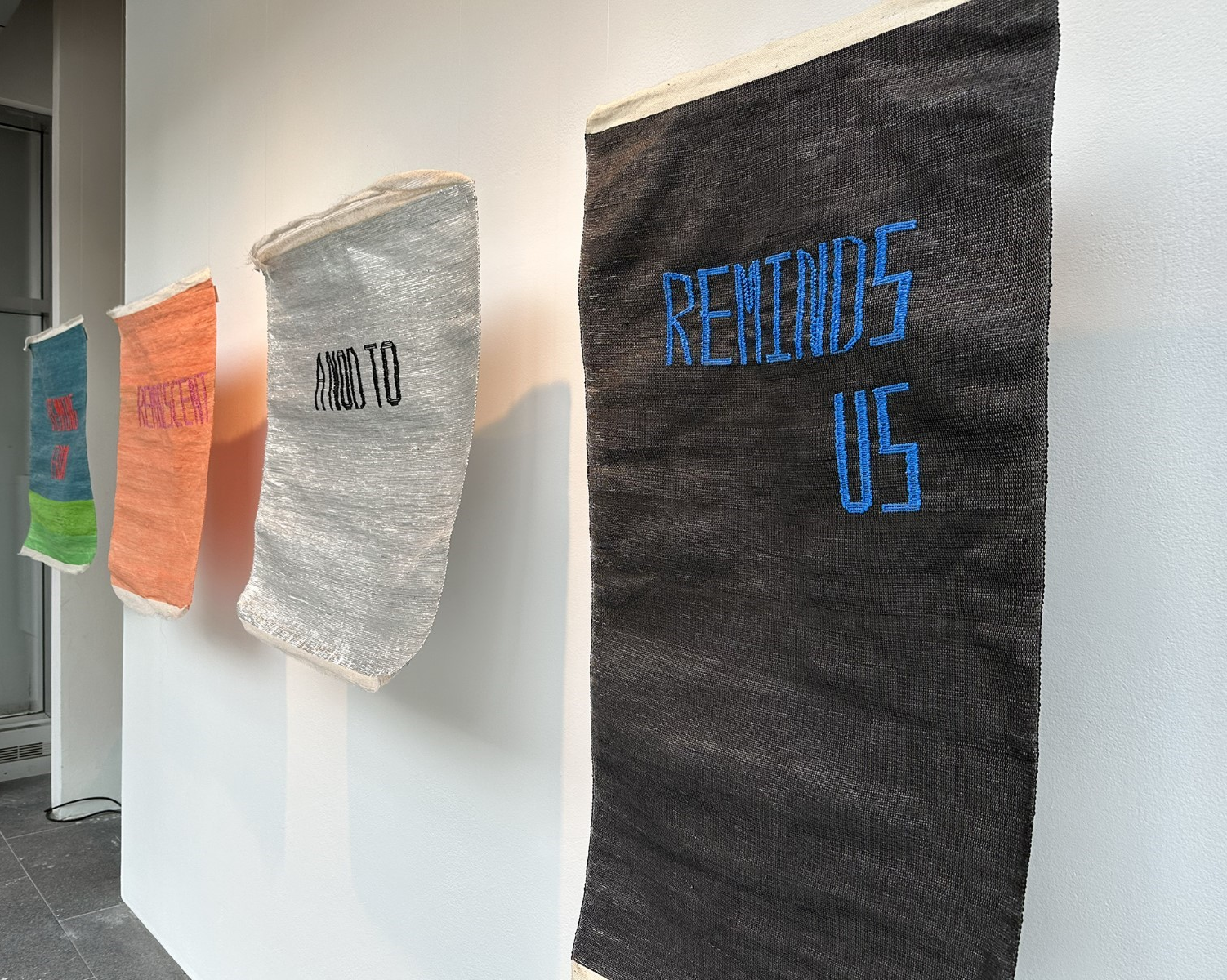 Swapnaa Tamhane, Recycled Plastic for Recycled Words (series), 2020-2021, Recycled Plastic Weaving made in collaboration with Premji Bhai, dimensions vary. Photo credit: Laurence Poirier
Swapnaa Tamhane, Recycled Plastic for Recycled Words (series), 2020-2021, Recycled Plastic Weaving made in collaboration with Premji Bhai, dimensions vary. Photo credit: Laurence Poirier
Recycled Plastics for Recycled Words
These plastic weavings are made by artisans in Kutch, Gujarat, with instructions that I send regarding the text and colour combinations. The recycling of plastic process involves taking plastic bags out of garbage dumps, sanitizing them, and cutting them into string which is then put on a spool using a charkha, or a spinning wheel. The plastic is then woven on a loom with a nylon warp and weft. The materials range from black and blue plastic carry bags to gold and silver biscuit wrappers. I sent over a series of phrases that I have encountered on exhibition labels or press releases, and these are phrases that are often used to help explain artworks particularly with artists of colour. Phrases like "a nod to", or "in reference to"... it’s always a nod to something we are supposed to know inherently, that being art from the West. The title speaks about the recycling process of plastic in relation to the recycling of these words or phrases.
These works are made with Premji Bhai, a weaver in Kutch, Gujarat.
About the artists
rudi aker
rudi aker is a wolastoqew auntie, artist, organizer, and curator from St. Mary’s First Nation in Sitansisk (Fredericton, New Brunswick) and, for now, a guest on Tiohtià:ke/Mooniyaang (Montreal, QC). Their artistic and research practices center relationality, placehood, and visibility, with a focus on the traversal of (un)colonized spaces through conceptions of counter-cartographies and barrier-breaking. Their ongoing research-creation project, topographies of a homeplace, explores the boundaries of cartographic practice through beaded spatial representations – hand-held topographical maps accompanied by historically and personally informed auto-writing on site-specific experiences. This work, in various iterations, has been included in Space, Place, Home (Louise-et-Reuben Cohen Art Gallery), Tactics for Staying Home in Uncertain Times (MSVU Art Gallery), HOST (third space gallery), window winnipeg, these are our monuments (Owens Art Gallery), ehpituwikuwam (Beaverbrook Art Gallery), and [espace variable | placeholder] (La Centrale Galerie Powerhouse).
For more information, visit rudiaker.com
Pansee Atta
Pansee Atta is an Egyptian-Canadian visual artist, curator, and researcher living and working on the unceded territory of the Algonquin Anishnaabe nation in Ottawa. Using a variety of new media, her work examines themes of representation, migration, archives, and political struggle. Previous residencies include the Impressions Residency Award at the Montréal Museum of Fine Arts, the SparkBox Studio Award, and at the Atelier of Alexandria. Previous exhibitions have taken place in collaboration with SAW Video in Ottawa, at Galerie La Centrale Powerhouse and Z Art Space in Montréal, the Art Gallery of Mississauga, and other contemporary Canadian arts spaces. Her curatorial projects include UTOPIAS, a community-based performance art festival in Kingston, Ontario, and Home/Making, an exhibition at the Canada Council Art Bank. Her ongoing research and activist practice centers community-based responses to colonial projects of collection, display, study.
For more information, visit panseeatta.com
Amin Rehman
Amin Rehman is a multidisciplinary visual artist who has been working since the1980s. Originally fromPakistan, he studied at the historic National College of Arts and the University of Punjab in Lahore. He received a Masters from the University of Windsor, Ontario in 2011. Rehman has exhibited extensively in a number of exhibitions across Canada, notably Other Histories at the Saint Mary’s University Art Gallery (2008); Hope at the Art Gallery of Regina (2014); A is for… at the McIntosh Gallery at the University of Western Ontario (2012) and White Wash at the Art Gallery of Mississauga, (2011). Rehman received the Canada Council for the Arts Project Grants to Visual Artists in 2014, 2017 and 2021. He also received the prestigious Chalmers Fellowship Award from the Ontario Arts Council twice, once in 2008 and then in 2017. He has received the grants from the Ontario Arts Council and the Toronto Arts Council 11 separate times since 2008. He was honoured with SAVAC’s (South Asian Visual Arts Centre) ‘Artist of the Year Award’ in 2005. Recently, his exhibition the Bleeding Borders was exhibited at the Art Gallery of Grande Prairie, Alberta from November 25, 2021, to March 20, 2022.
For more information, visit aminrehman.com
Swapnaa Tamhane
Swapnaa Tamhane is an artist, writer, and curator. Her visual practice is dedicated to drawing, making handmade paper, and working with the material histories of cotton and jute. Her interests extend to material culture, and with designer Rashmi Varma, she wrote SĀR: The Essence of Indian Design, Phaidon Press (2016). Curated exhibitions include In Order to Join – the Political in a Historical Moment (2013-2015) an exhibition of global feminisms at Museum Abteiberg, Mönchengladbach, and CSMVS, Mumbai, India; HERE: Locating Contemporary Canadian Artists (2017), Aga Khan Museum, Toronto, and CONSTITUTIONS (2021) at the Leonard & Bina Ellen Art Gallery, Montreal. She has an MFA in Fibres & Material Practices, Concordia University, where she is currently an Artist-in-Residence. Her artwork and research has been supported by SSHRC, Canada Council for the Arts, and Ontario Arts Council. She was a Research Fellow with the Shastri Indo-Canadian Institute (2009), and an International Museum Fellow with the Kulturstiftung des Bundes (2013-2014). In 2019, she was the Ontario juror for the Sobey Art Award, and is currently on the board of SAVAC. She has exhibited her work at articule, Montreal; Museum der Moderne, Salzburg; Serendipity Arts Festival, Panjim; and has held a solo exhibition at the Royal Ontario Museum, Toronto. In 2021, she was commissioned by the V&A Dundee, Scotland, to create a body of work around jute histories, which is currently on view.
For more information, visit tamhane.net
About the curators
Manar Abo Touk
Manar Abo Touk (she/her) is a Syrian-born Canadian independent art curator and a PhD student in the Department of Art History at Concordia University. Her dissertation project focuses on contemporary Syrian art post-2011. Specifically, it analyzes displacement on diasporic identities through artists in Canada, Germany, and France. Manar’s most recent positions were as the Arts Manager and Curator at Al Riwaq Art Space in the Kingdom of Bahrain, and the Curator of Exhibitions and Collections at the Art Gallery of Grande Prairie, Alberta.
Lorraine Doucet Sisto
Lorraine Doucet Sisto is an Art History MA student at Université du Québec à Montréal (UQAM). She is a research assistant and curator for Worlding Public Cultures. Lorraine works as a research assistant on Professor Edith-Anne Pageot’s research project, Une géographie des réseaux de production et de diffusion de la fibre dans l’art moderne et contemporain au Québec, contributing to mapping the history of textile arts in Quebec.
Varda Nisar
Varda Nisar (she/her) is a doctoral candidate in the Department of Art History, and Public Scholar at Concordia University. In 2021, she organized and convened a speaker series, (Art+Micro) History: Contemporary Artistic Voices from the South. Her current doctoral research focuses on the role that museums in Pakistan are playing in nation-building by positioning them within the global political dynamic.
Acknowledgements
The curatorial team would like to thank the Worlding Public Cultures Montreal Team members, Alice Ming Wai Jim, Analays Hernandez Alvarez, May Chew, maya rae oppenheimer, Edith-Anne Pageot and research assistant David Duhamel for their continued assistance, collaboration and mentorship.
Thank you to the following at Concordia University:
Conversations in Contemporary Art (maya rae oppenheimer and Karin Zuppiger), FOFA Gallery team (Nicole Burisch, Geneviève Wallen,María A. Escalona, Pierina Corzo-Valero, Laurence Poirier, and Jasmine Sirah) Webster Library (John Latour and team), Faculty of Fine Arts Department of Art History, Research Chair in Ethnocultural Art Histories, South-South Working Group, supported by Centre for Interdisciplinary Studies in Society and Culture (CISSC), and the Gail and Stephen A. Jarislowsky Institute for Studies in Canadian Art.

